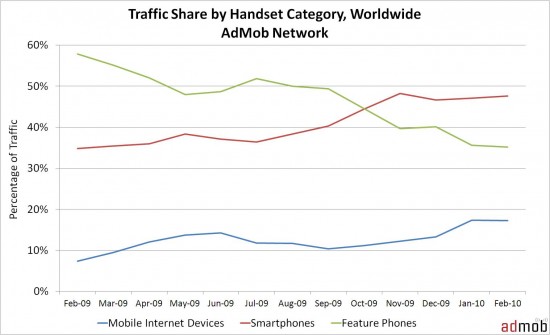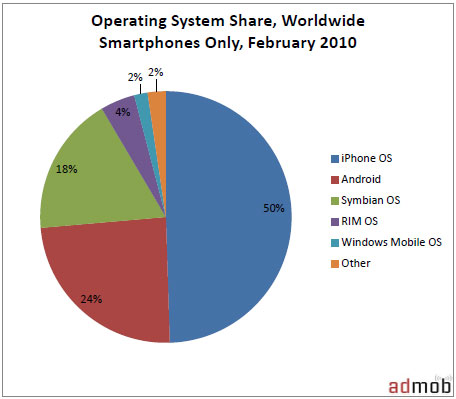Android Grows 1100% Year-Over-Year [ADMOB]
Admob just put out another of their oh-so-interesting reports, this time around looking at year-over-year mobile internet traffic from three main categories: (1) feature phones, (2) smartphones, and (3) MIDs. Two things really struck me as amazing. First of all, MIDs enjoyed the largest (percentage) growth as a category, probably because of their limited use and emergence as a product category.

But our beloved Android has a great story to tell, going from 2% of the market in February 2009 to 24% of the market in February 2010. Yup… that’s 1100% growth.

I must admit my statistical analysis is a bit rusty, but my calculation of GROWTH requires that the initial 2% be taken into consideration as the base, IN ADDITION to the “realized” growth so:
.02 + .02X = .24
.02X = .22
X=11
It is a bit of semantics, as first glance would appear Android grew 1200%, but for that to calculate properly you’d have to claim, “Android’s current market share is 1200% of what it was this time last year.” Those are two very different things, but correct me in the comments if I’m wrong. As usual, I didn’t have to ask, I know you will! ;)
Also interesting to note is the Top 5 Android devices worldwide, by traffic:
- Motorola Droid
- HTC Dream
- HTC Hero
- HTC Magic
- Motorola CLIQ
You also can’t ignore the consistent dominance of Apple and the iPhone. Android doesn’t seem to have bitten into the iPhone’s market share, but instead, has begun to join it in dominance. This is what I’ve suggested would happen all along, and its one of the main reasons I’m excited to see what the next version of the iPhone will bring us this year. After all, the innovations of one company lead to the innovations of all companies. Which lead to patent lawsuits.
I kid, I kid… but the summary of this Admob report? Android is still on the rise and with the slew of Androids at CTIA headlining the show, with consumers and analysts caring about little else in terms of mobile phones, I don’t see this pattern changing. At all.
Here is the full press release issued by Admob:
AdMob February 2010 Metrics Report Examines The Relative Growth in Smartphones, Feature Phones, and Mobile Internet Devices
Mobile Internet Devices Accounted for 17 Percent of Traffic in AdMob’s Network in February 2010, Up from Seven Percent in February 2009SAN MATEO, Calif., March 25, 2010 – AdMob, one of the world’s largest mobile advertising networks, separates the traffic in its network into three categories – smartphones, feature phones, and mobile Internet devices – to examine the growth rates of each over the past year in its February 2010 AdMob Mobile Metrics Report.
In February 2010, smartphones accounted for 48 percent of AdMob’s worldwide traffic, up from 35 percent in February 2009. The strong growth of iPhone and Android traffic, fueled by heavy application usage, was primarily responsible for increase. Although the share of feature phone traffic in AdMob’s network declined from 58 percent to 35 percent year-over-year, absolute traffic from feature phones still grew 31 percent. Mobile Internet devices experienced the strongest growth of the three categories, increasing to account for 17 percent of traffic in AdMob’s network in February 2010. The iPod touch is the top mobile Internet device and is responsible for vast majority of this traffic, other devices include the Sony PSP and Nintendo DSi.
Highlights from the February 2010 AdMob Mobile Metrics Report include:
* iPhone OS increased its share of smartphone requests from 33 percent in February 2009 to 50 percent in February 2010.
* Symbian’s share of smartphone requests fell from 43 percent in February 2009 to 18 percent in February 2010.
* Android increased its share from two percent in February 2009 to 24 percent in February 2010.
* The top five Android devices worldwide, by traffic, were the Motorola Droid, HTC Dream, HTC Hero, HTC Magic, and the Motorola CLIQ. The Google Nexus One only generated one percent of total Android traffic in February 2010.
* Samsung, Nokia, Sony Ericsson, Motorola, and LG were the top manufacturers of feature phones. Top feature phones from each manufacturer in AdMob’s network were the Samsung SCH R350, Nokia 3110c, Sony Ericsson W200i, Motorola RAZR V3, and LG CU920.For the purpose of categorization, AdMob considers a smartphone to run an identifiable Operating System, a feature phone to be mobile phone that does not fit into the smartphone category, and a mobile Internet device to be a handheld device that connects to the mobile Internet but is not a phone. AdMob has changed the format of the country pages in the February 2010 Report to include the top 10 smartphones and additional trended data.
AdMob stores and analyzes handset and operator data from every ad request in its network of more than 15,000 mobile Web sites and iPhone, Android, webOS, and Flash Lite applications to optimize ad serving. Each month, the AdMob Mobile Metrics Report aggregates this data to provide insights into major trends in the mobile ecosystem. The AdMob share is calculated by the percentage of requests received from a particular handset; it is a measure of relative mobile Web and application usage and does not represent handset sales. See additional detail on the methodology of the report at http://metrics.admob.com/2009/10/placing-admob-metrics-in-context/.
Visit AdMob’s Metrics Report blog (http://metrics.admob.com) to access the full February 2010 report, view past reports, or sign up to get an email notification when future reports become available. AdMob also recently conducted a survey of publishers in its network to gain insight into their future development plans and the results of that survey can also be accessed on the Metrics Report blog.
About AdMob
AdMob is one of the world’s largest mobile advertising networks, serving billions of mobile banner and text ads a month across a wide range of leading mobile Web sites and applications. AdMob helps advertisers connect with a relevant audience of consumers on mobile devices and gives publishers the ability to effectively monetize their mobile traffic. Incorporated in April 2006, AdMob provides the tools, data, and business models fueling the explosive growth of mobile media in more than 160 countries and territories worldwide.AdMob has been named one of the most innovative companies in advertising and marketing in 2009 by Fast Company magazine, a 2008 Technology Pioneer by the World Economic Forum, and one of Wired.com’s 2008 Companies to Watch. AdMob works with thousands of advertisers and publishers, including Adidas, CBS News, Gap, Lonely Planet, MovieTickets.com, MySpace, P&G, Tapulous, and Universal Pictures. To learn more about AdMob, visit www.admob.com.
Check out the full report and read how they collect their data and arrive at conclusions.
